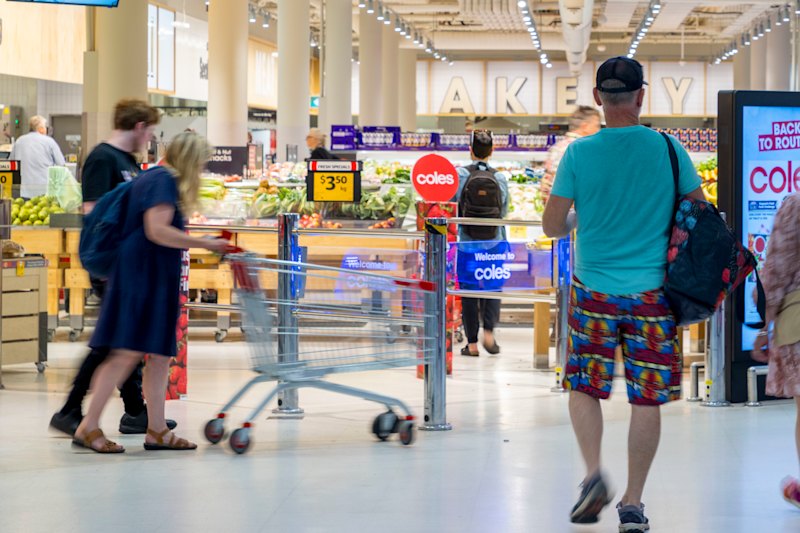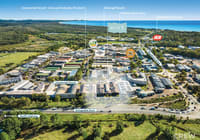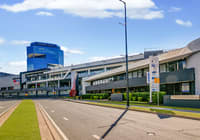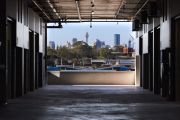
Hotel developers embrace Lego-style building methods
In June this year, a convoy of 80 semi-trailers snaked their way down the Hume Highway from Sydney to the Rules Club Wagga Wagga in the NSW Riverina.
Each truck carried a 26 square metre fully completed guest room and bathroom. Once delivered alongside the construction site, these modules were stacked like building blocks to a height of three stories alongside a small traditionally-built lobby and office, then clad and finished to create a new four-star Quality Hotel.
From start to finish the $10 million modular hotel will take just seven months to build, cutting construction time by almost half, slashing wastage six-fold and delivering hotel rooms at $110,000 a key – “significantly cheaper” than a traditional hotel build, according to Trent Fraser, Asia Pacific CEO of Choice Hotels.
 A room is lowered into place at the new Rules Club at Wagga Wagga. Photo: Supplied
A room is lowered into place at the new Rules Club at Wagga Wagga. Photo: Supplied
The club will own and operate the new hotel under a franchise agreement with Choice Hotels, providing accommodation to corporate guests during the week and leisure and sporting visitors to Wagga on the weekend.
“It’s the first modular-constructed hotel in Australia fully-funded by an Australian bank (the Commonwealth Bank) and its created a platform for other operators,” Fraser says.
“There’s lots of sporting clubs in metro and regional ares with vacant or available land so I see huge opportunities in this space.”
 Trent Fraser, Asia Pacific CEO of Choice Hotels: “There’s lots of sporting clubs in metro and regional ares with vacant or available land so I see huge opportunities in this space.” Photo: Josh Robenstone
Trent Fraser, Asia Pacific CEO of Choice Hotels: “There’s lots of sporting clubs in metro and regional ares with vacant or available land so I see huge opportunities in this space.” Photo: Josh Robenstone
Thousands of kilometres away, in Perth, ASX-listed Mantra Group will open two new prefabricated hotels before the end of the year: rising 17 stories, the $25 million Peppers Kings Square in the CBD, featuring modular bathrooms, pre-attached facades and precast concrete panels designed by the Hickory Group, will be the tallest prefabricated hotel in Australia.
Also under construction is the $30 million Tribe Hotel in West Perth. Developed by the Tribe Hotel Group and its BRW rich-lister joint venture partners, Salta Properties and Victor Smorgon Group, all 126 rooms are prefabricated, consisting of 63 fully-fitted two-room modules, built in a factory in China, then shipped to Perth to be “stacked up like Lego”.
“Gone are the days of traditional hotel design,” says Mantra Group’s director of acquisitions, Michael Moret-Lalli, “Modular-built hotels are the emerging trend.”
Hotel construction booms
These state-of-the art hotels are part of pipeline of more than 8000 hotel rooms under construction across Australia as the country experiences its biggest hotel construction boom since the late 1980s.
With occupancy rates rising nationally, led by 85 per cent plus levels in Sydney and Melbourne, and room rates lifting as well, new hotel developments are stacking up better financially.
At the same time, developers, investors and operators are getting smarter about delivering a carefully curated hotel experience that meet the needs of increasingly fragmented traveller market.
“Its now about return per square metre,” Moret-Lalli says. “For many new hotels, you don’t need the big back of house facilities or the big conference rooms or multiple restaurants. Now everything is very tailored and cost engineered for maximum return.”
 An artist’s impression of the $30 million Tribe Hotel in West Perth, developed by the Tribe Hotel Group and its BRW rich-lister joint venture partners, Salta Properties and Victor Smorgon Group. Image: Supplied
An artist’s impression of the $30 million Tribe Hotel in West Perth, developed by the Tribe Hotel Group and its BRW rich-lister joint venture partners, Salta Properties and Victor Smorgon Group. Image: Supplied
At the more budget-conscious end of the market, tech-savvy millennials with a thirst for well-designed, high quality finishes and seamless social spaces are driving modular hotel construction and more efficiently designed hotels in fringe CBD and suburban locations.
“They don’t spend a lot of time in their room, so these can be smaller. But they must be well fitted and offer the best in terms of technology,” says Moret-Lalli.
Meeting the demands of the modern traveller is perhaps best personified in Intercontinental Hotel Group’s fast expanding limited service Holiday Inn Express chain and its catch-phrase: “Giving guests everything they need and nothing they don’t”.
Fourteen of these limited service hotels are under development in Australia, with one in Macquarie Park already completed, as part of a franchise agreement between developer and operator Pro-invest and IHG.
Redesigned rooms
“As construction and operational costs rise and land becomes more expensive, hoteliers need to do more with less but still deliver on guest expectations and ensure a great return for owners,” says Matthew Tripolone, IHG’s head of development in Australasia.
Rooms in Holiday Inn Expresses are about 30 per cent smaller than a traditional hotel room, measuring 19-20 square metres. But space has been maximised and optimised to suit the needs of guests.
Innovations include removing desks from rooms in favour of flexible workspaces and designing bathrooms with a single door for both the shower and bathroom itself to get the most out of the space.
“We’ve scaled back on desks in rooms in favour of flexible workspaces. The corporate traveller does not want or need a corporate desk. They prefer a day bed or coffee table to work on,” says Tripolone.
Holiday Inn Express foyers are also designed for the most efficient use of space; the reception desk doubles as a restaurant and bar with staff trained to check guests in, pour them a drink and serve them a sandwich.
While the hotel offers small meeting rooms, there are no conference facilities because most guests conduct their business meetings at other locations. There’s also no traditional hotel restaurant, because guests tend to work long hours or go out for dinner.
“We cater for a guest who wants a good, functional room with good technology, that requires breakfast and close access to their place of business,” Tripolone says.
The Holiday Inns are still being built using traditional pre-cast concrete methods, but Mr Tripolone says IHG is exploring exploring modular builds.
“We are not yet seeing the significant savings that we would like to see from this technology, but are continuing to work on various options.”
Luxury sticks with tradition
Traditional building methods still dominate the more luxury end of the hotel market. But the exorbitant cost of land in the major capital cities – a factor of the high-rise apartment boom – is driving another major innovation: hotels as part of mixed-use precincts.
“A hotel component makes sense as part of broader precinct with multiple income sources and demand drivers. The hotel usually forms the cornerstone of the development and is its heart and soul,” says Mantra’s Moret-Lalli.
“The hotel helps drive residential sales in the development by offering residents value-add hotel services like valet parking, house-keeping and room service.
Moret-Lalli says developers have a preference for luxury hotels because they add “a bit more cache” – as seen with plans for a six-star Crown casino and hotel at Barangaroo and the 600-room Sofitel Sydney Darling Harbour hotel which will open next year as part of the new $3.4 billion International Convention Centre at Darling Harbour.
In Brisbane, listed construction firm Watpac is building three new hotels that are typical of the mixed-use philosophy.
Watpac is building BRW richlister Sam Chong’s $325 million Mary Lane development in the CBD featuring a 286-room Westin Hotel plus shops and apartments within a 37-level tower, while out at the airport Watpac is constructing the Flynn brothers’ $150 million Brisbane Airport Hotels and Conference Centre incorporating a 5-star, 130 room Pullman Hotel and 3.5 star, 243 room Ibis Hotel.
“For a long time the investment equation did not stack up. Hotels had a reputation for only making a profit for the second owner, so there was heavy under-investment,” says Watpac managing director, Martin Monro
‘The variables have changed and it’s now much more economical. At the same time hotels are reinventing themselves, becoming parts of broader activations, as you see with Mary Lane.”
“In this case, the developer is leveraging off the hotel lobby, traditionally an exciting and vibrant place, an adding retail and residential.”
At the airport development, Monro says building a conference centre with a hotel on either side creates size and scale and delivers critical mass. “The word is full of uninspiring airport hotel precincts. This will not be one of them.”
Far away from the bright lights of Brisbane, the Wagga Wagga the Rules Club board and its members are excitedly awaiting the opening of the Quality Inn in about four weeks time.
“We initially had reservations [about a modular hotel] but we went and saw and existing modular-built hotel in Bendigo and were satisfied that the quality would be excellent,” said club general manager Jack Jolly.
“We moved on from the cheapness of containerised systems,” says Conrad Axton, a director at Sydney-based Axian Group, who acted as project managers and specialist modular consultants on the project.
“The [Wagga Wagga] hotel is one of the most innovative and efficiently developed hotels and conference centres in the country thanks to its unique off site construction and modular delivery method. It’s landmark in Australian hotel construction.”
“Looking at the finished hotel, you would not know its modularised.”











